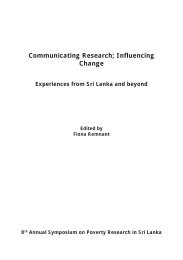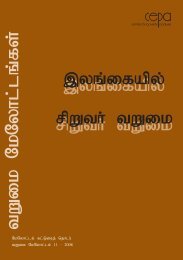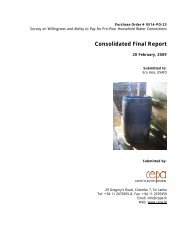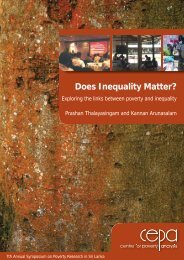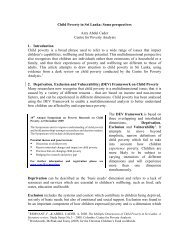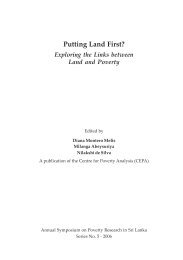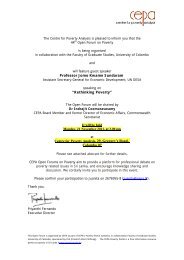Involuntary Displacement and Resettlement â Policy and ... - CEPA
Involuntary Displacement and Resettlement â Policy and ... - CEPA
Involuntary Displacement and Resettlement â Policy and ... - CEPA
- No tags were found...
You also want an ePaper? Increase the reach of your titles
YUMPU automatically turns print PDFs into web optimized ePapers that Google loves.
livelihoods of the affected people beyond compensation. These guidelines<strong>and</strong> measures were built with the idea that at the end of the planned activity,the lives of the affected people will be better off, both in terms of economic<strong>and</strong> socio cultural, living st<strong>and</strong>ard terms.It is in that context, that Cernea (1997) 5 views that “the primary objective ofany induced involuntary resettlement process should be to preventimpoverishment <strong>and</strong> to reconstruct <strong>and</strong> improve the livelihood of resettlers”. Inhis Impoverishment Risks <strong>and</strong> Reconstruction (IRR) Model, among the eightrisks of resettlement, Cernea identifies“joblessness” as a risk of resettlement.It occurs both in rural <strong>and</strong> urban displacements, due to loss of l<strong>and</strong> <strong>and</strong>services. Usually the period of unemployment does not end with physicalrelocation. In essence the IRR model emphasises the management of theserisks before the project starts, during the project implementation <strong>and</strong> after thecompletion of the project to encourage faster recovery.The risk of joblessness after resettlement arises from the fact that establishingemployment <strong>and</strong> livelihoods take time <strong>and</strong> investment. Here, there is a greaterneed to view the resettlement process beyond the point of compensation <strong>and</strong>to make it a process that helps the actual recovery of the affected people. TheIRR model provides input at two levels. At policy level, these risks can bemitigated when making resettlement policies, <strong>and</strong> at the strategy level, greaterthought can be given to the resettlement plans of specific projects, to bedeveloped in consultation with all stakeholders in the resettlement. Providingl<strong>and</strong> for l<strong>and</strong> loss, shelter for shelter loss <strong>and</strong> re-establishment of communitynetworks <strong>and</strong> resources are ways in which risks of unemployment can beaddressed.The IRR model further specifically recommends that provisions on employmentpromotion/creation should be a part of the resettlement plan, so that it canincrease the awareness of the risk <strong>and</strong> stimulate methods to increase employmentoptions.Along with this, the IRR model also proposes four activities that can increaselivelihood restoration of affected people in instances of DIDR: a) Createemployment opportunities for the affected people <strong>and</strong> people in the adjacent5Michael Cernea, “The Risks <strong>and</strong> Reconstruction Model for Resettling Displaced Populations,”World Development, Vol. 25(10), 1997.46



